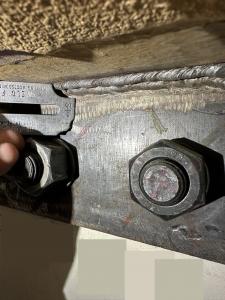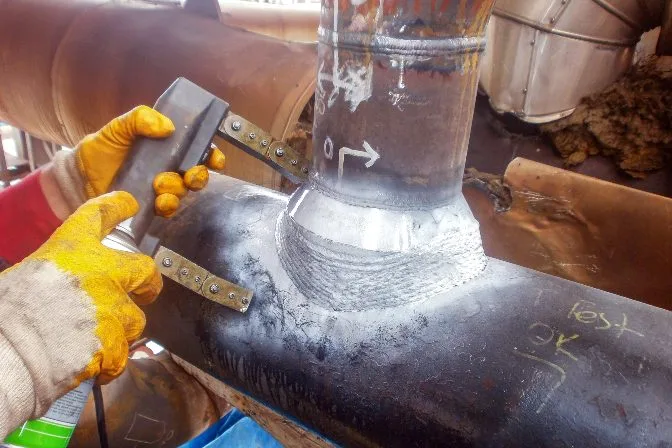Innovative Approaches to Fillet Weld Inspection and Testing: Enhancing Weld Quality and Compliance Standards
In the realm of welding, the quality and integrity of fillet welds play a crucial role in guaranteeing the structural stability and reliability of various commercial parts. With the consistent drive for boosted performance and conformity with rigid requirements, the exploration of innovative approaches to fillet weld inspection and screening has actually ended up being crucial. As sectors progress, the standard methods may no much longer be adequate in satisfying the demands of modern welding applications. By welcoming innovative innovations and methodologies, a brand-new horizon of possibilities arises in the realm of weld quality analysis and adherence to compliance criteria.
Advanced Non-Destructive Testing Approaches
Utilizing modern technologies, progressed non-destructive screening techniques play a critical role in making certain the integrity and high quality of fillet welds. These approaches, such as phased range ultrasonic screening (PAUT) and magnetic particle testing (MPT), deal detailed insights right into the weld's inner structure without triggering any kind of damage to the material. PAUT, for circumstances, makes use of multiple ultrasonic aspects to check the weld from numerous angles, offering a comprehensive visualization of potential issues like absence of fusion or fractures.
By employing these advanced non-destructive screening strategies, weld examiners can precisely evaluate the quality of fillet welds, ensuring conformity with market requirements and policies. The ability to identify imperfections early on not just improves weld quality yet likewise avoids costly rework or failings in structural integrity, underscoring the relevance of these innovative screening techniques in welding evaluations.
Robotics and Automation in Inspection
The assimilation of robotics and automation has revolutionized the examination process for fillet welds, enhancing performance and accuracy in top quality evaluation. Robotics offer exact control and repeatability in examining welds, making certain trusted and constant results. Automated systems can be configured to adhere to particular inspection paths, making certain complete coverage of welds and lowering the risk of human mistake.
Robot evaluation systems outfitted with sophisticated sensing units can spot and determine weld features with high precision, giving comprehensive information for evaluation. These systems can identify problems such as splits, lack of combination, and porosity, making it possible for punctual corrective activities to be taken. In addition, robotics and automation enable real-time information collection and analysis, supplying prompt feedback to operators and assisting in fast decision-making processes.
Additionally, making use of robotics and automation in fillet weld inspection improves general efficiency by lowering inspection times and enhancing assessment throughput. By simplifying the examination procedure, manufacturers can guarantee weld high quality and compliance criteria are fulfilled successfully, inevitably leading to set you back financial savings and boosted item top quality.
Making Use Of Artificial Intelligence for Evaluation
Man-made intelligence plays a crucial function in enhancing the effectiveness and precision of analysis in fillet weld inspection procedures. AI algorithms can quickly process substantial amounts of information from Home Page weld evaluations, detecting flaws or inconsistencies that might be challenging to determine with the naked eye - Welding Inspection Racine.
Furthermore, AI systems can pick up from past assessment information, continually enhancing their capacity to identify prospective issues and discrepancies in fillet welds. This flexible understanding capability improves the general quality assurance process, decreasing the probability of human mistake and ensuring that welds meet the needed requirements. By incorporating fabricated knowledge into fillet weld analysis, industries can accomplish higher levels of effectiveness, uniformity, and conformity in their examination techniques.
Portable Tools for On-Site Inspection
 Enhancing area examination efficiency, the adoption of portable tools transforms on-site evaluation procedures for fillet welds. These devices offer flexibility and benefit, enabling examiners to carry out detailed examinations in various locations, including challenging or remote environments. Portable tools such as ultrasonic screening tools, magnetic particle inspection equipment, and electronic radiography systems provide real-time information and high-resolution imaging capacities, making it possible for fast decision-making and prompt comments on weld high quality.
Enhancing area examination efficiency, the adoption of portable tools transforms on-site evaluation procedures for fillet welds. These devices offer flexibility and benefit, enabling examiners to carry out detailed examinations in various locations, including challenging or remote environments. Portable tools such as ultrasonic screening tools, magnetic particle inspection equipment, and electronic radiography systems provide real-time information and high-resolution imaging capacities, making it possible for fast decision-making and prompt comments on weld high quality.One considerable advantage of portable tools is their ability to streamline examination treatments, lowering downtime and boosting general efficiency. Inspectors can easily transfer these tools to different work websites, eliminating the demand for moving hefty equipment or elements to off-site facilities. Additionally, the portability of these devices advertises cost-effectiveness by reducing transportation expenses and accelerating inspection timelines.
Moreover, using portable devices for on-site evaluation promotes aggressive quality assurance steps, as inspectors can without delay recognize and deal with any possible welding flaws or inconsistencies. By incorporating these cutting-edge modern technologies right into on-site evaluation techniques, welding experts can ensure compliance with sector requirements and enhance weld top quality, inevitably bring about boosted architectural stability and security in various welding applications.
Combination of Information Management Solution
Having actually optimized on-site assessment processes with the utilization of mobile devices, the following phase includes the smooth integration of information monitoring systems to even more more helpful hints improve performance and data analysis abilities in fillet weld examination and testing. Welding Inspection Racine. By integrating information monitoring systems right into the inspection process, organizations can enhance information collection, storage, and analysis. This assimilation permits real-time surveillance of weld top quality, immediate identification of problems, and timely decision-making to remedy any kind of concerns that might arise during the inspection process
The integration of information administration systems allows seamless interaction between various stakeholders involved in index the evaluation process, cultivating partnership and enhancing general quality control procedures. Ultimately, the combination of information administration systems offers to elevate the standards of fillet weld assessment and testing, making sure conformity with market laws and improving weld top quality.
Conclusion
In final thought, cutting-edge methods to fillet weld examination and testing have actually considerably improved weld top quality and compliance requirements. Advanced non-destructive screening methods, robotics, automation, man-made knowledge, portable tools, and data monitoring systems have actually transformed the method weld assessments are performed. By utilizing these innovations, sectors can ensure that welds satisfy the needed top quality standards and policies, eventually boosting total efficiency and security in welding procedures.

By using these innovative non-destructive screening strategies, weld assessors can properly assess the quality of fillet welds, ensuring compliance with industry standards and policies. Mobile devices such as ultrasonic screening tools, magnetic particle inspection tools, and digital radiography systems offer real-time data and high-resolution imaging capacities, enabling quick decision-making and immediate comments on weld high quality.
Having enhanced on-site evaluation processes through the application of mobile tools, the next stage includes the seamless integration of information administration systems to even more enhance performance and information analysis capacities in fillet weld assessment and testing (Welding Inspection Racine). Ultimately, the assimilation of data management systems offers to raise the standards of fillet weld examination and testing, guaranteeing conformity with market regulations and boosting weld high quality
 In verdict, ingenious approaches to fillet weld examination and screening have significantly improved weld quality and conformity standards.
In verdict, ingenious approaches to fillet weld examination and screening have significantly improved weld quality and conformity standards.